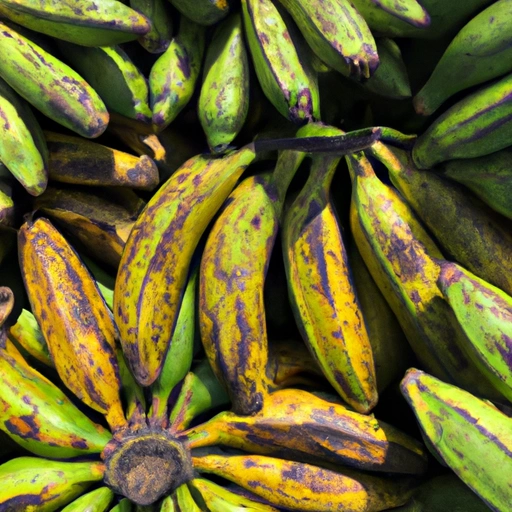Plantain
Description

Plantain, a staple ingredient in many tropical regions of the world, is a variety of banana that is usually consumed cooked rather than raw. Unlike its sweeter counterpart, the plantain is starchy and low in sugar, making it more akin to a vegetable than a fruit in terms of culinary uses. Plantains are typically larger and tougher than bananas and have thicker skins. They can range in color from green to yellow to black, depending on their ripeness.
Common uses
Plantains are widely used as a carbohydrate source in many tropical regions. They are versatile and can be prepared at various stages of ripeness, each offering a different texture and flavor profile. Green plantains are firm and starchy, well-suited for frying or boiling. As they ripen to yellow and then black, they become softer and sweeter, lending themselves to different types of dishes.
Nutritional value
Calories
A medium-sized plantain, weighing approximately 179g, provides about 218 calories (912 kJ).
Protein
Each plantain contains around 2g of protein, using both metric (grams) and imperial (ounces) measurements.
Fat
Plantains are very low in fat, with less than 0.5g per medium-sized fruit.
Carbohydrates
Carbohydrates are the primary macronutrient in plantains, with about 57g present in a medium-sized plantain.
Vitamins
Plantains are a good source of vitamins, particularly vitamin A and vitamin C, as well as some B-vitamins such as folate.
Minerals
They also provide essential minerals like potassium, magnesium, and iron.
Health benefits
Plantains are rich in fiber, which can aid in digestion and help regulate blood sugar levels. The high potassium content also supports heart health by maintaining proper blood pressure and muscle function. As they contain antioxidants, they can contribute to reducing oxidative stress and inflammation in the body.
Potential risks
Plantains are generally safe to eat; however, they should be consumed in moderation due to their high carbohydrate content, which may affect blood sugar levels in people with diabetes. Additionally, cooking plantains at high temperatures can produce harmful compounds like acrylamide.
Common recipes
Plantains are commonly used in recipes such as fried plantains, plantain chips, mofongo, and maduros. They are also mashed, boiled, or made into porridge.
Cooking methods
Depending on their ripeness, plantains can be boiled, fried, baked, or grilled to create a variety of dishes from savory to sweet.
Pairing with other ingredients
Plantains pair well with a variety of flavors, including savory spices, herbs, meats, and other vegetables. They also complement sweet accompaniments such as honey, cinnamon, and nutmeg.
Summary
Plantains are a nutritious and versatile ingredient that can be used in a wide range of dishes. They provide essential nutrients and have several health benefits while being an integral part of many cultural cuisines. With their ability to be cooked in various ways, plantains can be included in both sweet and savory recipes, making them a beloved ingredient worldwide.